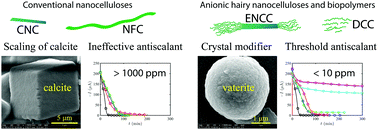当前位置:
X-MOL 学术
›
Mater. Horiz.
›
论文详情
Our official English website, www.x-mol.net, welcomes your
feedback! (Note: you will need to create a separate account there.)
Nanoengineering colloidal and polymeric celluloses for threshold scale inhibition: towards universal biomass-based crystal modification†
Materials Horizons ( IF 12.2 ) Pub Date : 2018-01-22 00:00:00 , DOI: 10.1039/c7mh00823f Amir Sheikhi 1, 2, 3, 4, 5 , Ashok Kakkar 1, 2, 3, 4, 5 , Theo G. M. van de Ven 1, 2, 3, 4, 5
Materials Horizons ( IF 12.2 ) Pub Date : 2018-01-22 00:00:00 , DOI: 10.1039/c7mh00823f Amir Sheikhi 1, 2, 3, 4, 5 , Ashok Kakkar 1, 2, 3, 4, 5 , Theo G. M. van de Ven 1, 2, 3, 4, 5
Affiliation

|
The first family of threshold (ppm level) cellulose-based scale inhibitors and crystal modifiers has been developed through the chemical nanoengineering of cellulose fibrils, the building blocks of plant cell walls, overcoming the structural and chemical limitations of conventional nanocelluloses. Dicarboxylated hairy cellulose nanocrystals and biopolymers address one of the most tenacious challenges of water-based industries, i.e., the scaling of inorganic salts, providing a green, environmentally-friendly alternative to the current phosphonated macromolecules. This research may shape the future of biomass-based antiscalants and advance the field of organic–inorganic biomimetic nanocomposites based on the most abundant biopolymers in the world.
中文翻译:

纳米工程化的胶体和聚合物纤维素,可抑制阈值水垢:实现基于生物质的通用晶体改性†
通过克服纤维素原纤维的化学纳米工程技术,植物细胞壁的基础材料,克服了常规纳米纤维素的结构和化学局限性,已经开发出第一类阈值(ppm级)基于纤维素的阻垢剂和晶体改性剂。二羧基化毛状纤维素纳米晶体和生物聚合物解决了水基工业最顽强的挑战之一,即无机盐的结垢,为目前的膦酸酯化大分子提供了绿色,环保的替代品。这项研究可能会塑造基于生物质的防垢剂的未来,并推动基于世界上最丰富的生物聚合物的有机-无机仿生纳米复合材料的领域。
更新日期:2018-01-22
中文翻译:

纳米工程化的胶体和聚合物纤维素,可抑制阈值水垢:实现基于生物质的通用晶体改性†
通过克服纤维素原纤维的化学纳米工程技术,植物细胞壁的基础材料,克服了常规纳米纤维素的结构和化学局限性,已经开发出第一类阈值(ppm级)基于纤维素的阻垢剂和晶体改性剂。二羧基化毛状纤维素纳米晶体和生物聚合物解决了水基工业最顽强的挑战之一,即无机盐的结垢,为目前的膦酸酯化大分子提供了绿色,环保的替代品。这项研究可能会塑造基于生物质的防垢剂的未来,并推动基于世界上最丰富的生物聚合物的有机-无机仿生纳米复合材料的领域。











































 京公网安备 11010802027423号
京公网安备 11010802027423号